1.ArrayBlockingQueue
·属性
/** The queued items */
final Object[] items;
/** items index for next take, poll, peek or remove */
int takeIndex;
/** items index for next put, offer, or add */
int putIndex;
/** Number of elements in the queue */
int count;
/** Main lock guarding all access */
final ReentrantLock lock;
/** Condition for waiting takes */
private final Condition notEmpty;
/** Condition for waiting puts */
private final Condition notFull;
public ArrayBlockingQueue(int capacity, boolean fair) {
if (capacity <= 0)
throw new IllegalArgumentException();
this.items = new Object[capacity];
lock = new ReentrantLock(fair);
notEmpty = lock.newCondition();
notFull = lock.newCondition();
}
可以看出来该类是使用ReentrantLock和两个条件队列来保证多线程安全的。并且只有一把锁,也就意味着同一时刻只能有一个线程进来操作。
结构如下:
 ·put()
·put()
相当于生产者
public void put(E e) throws InterruptedException {
checkNotNull(e); //插入的元素不能为null
final ReentrantLock lock = this.lock;
lock.lockInterruptibly();//先获取可中断锁
try {
while (count == items.length) //如果数组满了,那么不能进行放的操作,去条件队列等待
notFull.await();
enqueue(e); //放到数组中去
} finally {
lock.unlock();
}
}
private void enqueue(E x) {
// assert lock.getHoldCount() == 1;
// assert items[putIndex] == null;
final Object[] items = this.items; //获取数组
items[putIndex] = x; //放到数组中
if (++putIndex == items.length) //如果放入该元素后等于数组的容量,那么让put下标指向0,可以看出这里是一个循环数组
putIndex = 0;
count++; //数量+1
notEmpty.signal();//唤醒因为没有元素而阻塞的消费者线程(take线程)
}
·take()
相当于消费者
public E take() throws InterruptedException {
final ReentrantLock lock = this.lock;
lock.lockInterruptibly(); //拿锁
try {
while (count == 0) //如果数组中没有元素,那么不能拿,去条件队列中等待
notEmpty.await();
return dequeue(); //否则返回拿到的值
} finally {
lock.unlock();
}
}
private E dequeue() {
// assert lock.getHoldCount() == 1;
// assert items[takeIndex] != null;
final Object[] items = this.items; //拿到数组
@SuppressWarnings("unchecked")
E x = (E) items[takeIndex];//拿到对应下标的值
items[takeIndex] = null; //已经被拿走了,这个坑位就不再需要保存当前值了
if (++takeIndex == items.length) //如果已经拿到最后一个了,那么让takeIndex回到数组开始位置
takeIndex = 0;
count--; //数量-1
//...忽略即可
notFull.signal(); //唤醒因为队列满了而不能放的生产者线程(因为我这里已经消费了,所以你可以生产了)
return x; //返回拿到的值
}
·remove()
public boolean remove(Object o) {
if (o == null) return false;
final Object[] items = this.items;
final ReentrantLock lock = this.lock;
lock.lock(); //上锁
try {
if (count > 0) { //如果数组中没有元素,那还移除什么东西?直接返回false
final int putIndex = this.putIndex;
int i = takeIndex;
do {
if (o.equals(items[i])) { //通过equals来判断是否包含,如果有则移除
removeAt(i); //这个方法就不看了,我们可以想想在数组中删除一个元素是如何删除的?如果是最后一个元素那么就不用移动直接删除即可,否则必须要移动,逻辑比较简单,我就不赘述了
return true;
}
if (++i == items.length)//如果到达数组尾部,那么将i从数组开始继续找(因为这是个循环数组,可能出现takeIndex在putIndex的后面)
i = 0;
} while (i != putIndex); //直到追上putIndex为止
}
return false;
} finally {
lock.unlock();
}
}
可以看到基于数组实现的BlockIngQueue是由一把大锁实现的,生产者和消费者只能有一个进行,那么如果生产者生产了两个,这个时候生产者没有释放锁,消费者还是要等着,这样效率是否有点低下?
2.LinkedBlockingQueue
·属性
static class Node<E> {
E item; //用于保存值
Node<E> next; //用于保存下一个节点
}
private final int capacity;
private final AtomicInteger count = new AtomicInteger();
transient Node<E> head;
private transient Node<E> last;
private final ReentrantLock takeLock = new ReentrantLock();
private final Condition notEmpty = takeLock.newCondition();
private final ReentrantLock putLock = new ReentrantLock();
private final Condition notFull = putLock.newCondition();
public LinkedBlockingQueue(int capacity) {
if (capacity <= 0) throw new IllegalArgumentException();
this.capacity = capacity;
last = head = new Node<E>(null);
}
可以看到链表实现的阻塞队列和数组实现的阻塞队列的不同,在这里锁分为了put锁(生产者锁)和take锁(消费者锁),也就意味着消费者和生产者可以并发执行。并且在创建的时候就初始化了伪节点(head和tail),并且伪节点的是不存放数据的(item=null),
初始化的状态如下:

·put()
生产者线程
public void put(E e) throws InterruptedException {
if (e == null) throw new NullPointerException();//不能放null的值
int c = -1; // 临时变量c
Node<E> node = new Node<E>(e);//创建新的节点
final ReentrantLock putLock = this.putLock;
final AtomicInteger count = this.count;//拿到此时队列中的元素个数
putLock.lockInterruptibly(); //拿到锁
try {
while (count.get() == capacity) {//如果此时队列满了,那么不能放,直接进入条件队列等待
notFull.await();
}
enqueue(node);//否则,放入到队列中(尾插)
c = count.getAndIncrement();//注意这个方法是返回原来的数量,也就是此时c=原来队列中有多少个元素
if (c + 1 < capacity) //如果当前线程插入之后还小于容量,那么唤醒我的兄弟(因为队列满了无法插入而去条件队列中阻塞的生产者线程)
notFull.signal();
} finally {
putLock.unlock();
}
if (c == 0) //如果放入元素之前队列是空的,那么唤醒因为队列为空而无法take()的消费者线程(因为此时我已经放入了一个元素了)
signalNotEmpty();
}
private void enqueue(Node<E> node) {
last = last.next = node; //可以看出来是尾插法
}
·take()
消费者线程
public E take() throws InterruptedException {
E x;
int c = -1; //临时变量
final AtomicInteger count = this.count;
final ReentrantLock takeLock = this.takeLock;
takeLock.lockInterruptibly(); //获取锁
try {
while (count.get() == 0) { //如果此时队列中没有东西可拿,那么在等待队列中去阻塞
notEmpty.await();
}
x = dequeue(); //否则去队列中拿一个元素(头拿)
c = count.getAndDecrement(); //返回count之前的值
if (c > 1) //如果之前还有不止一个元素,那么唤醒我的兄弟起来消费(因为队列为空而无法消费去等待队列阻塞的线程)
notEmpty.signal();
} finally {
takeLock.unlock();
}
if (c == capacity) //如果在拿元素之前的队列是满的,那么唤醒因为队列满而无法放入元素的生产者线程(因为此时我已经消费了一个元素了)
signalNotFull();
return x;
}
private E dequeue() { //可以看到是头拿的
Node<E> h = head; //拿到头节点
Node<E> first = h.next; //拿到头节点的后一个节点
h.next = h; // help GC 将伪节点的next设置为自己
head = first;//更换头节点
E x = first.item;//需要返回的值
first.item = null;//
return x;
}
·remove()
public boolean remove(Object o) {
if (o == null) return false;
fullyLock(); //拿到两把锁
try {
for (Node<E> trail = head, p = trail.next;
p != null; //单链表的移除操作,没什么好讲的了(唯一需要注意的点是:如果在移除之前队列是满了,那么肯定最后会有个唤醒因为队列满而不能put()的生产者线程,也即 notFull.signal()操作)
trail = p, p = p.next) {
if (o.equals(p.item)) {
unlink(p, trail);
return true;
}
}
return false;
} finally {
fullyUnlock();
}
}
·contains
查询队列中是否包含某个元素。可想而知,如果我在这里查找,而生产者在生产,消费者在消费,这明显不符合常理,所以要执行查找方法就必须拿到两把锁才能执行。否则没有意义。
public boolean contains(Object o) {
if (o == null) return false;
fullyLock(); //拿到两把锁
try {
//可以看出时间复杂度是O(n)
for (Node<E> p = head.next; p != null; p = p.next) //从第二个节点开始找(伪节点不存放数据)
if (o.equals(p.item))
return true;
return false;
} finally {
fullyUnlock();
}
}
void fullyUnlock() { //拿到生产者和消费者两把锁
takeLock.unlock();
putLock.unlock();
}
思考:
1.如果初始节点只有1个伪节点,那么生产者和消费者同时操作的时候是否会有冲突?
2.生产者和消费者同时操作链表是否存在问题?
·1.不会,因为存在count时,put和take操作在最开始的时候都会判断count值,如果take线程先判断count==0,那么就会去睡眠,然后put线程放了一个元素,并且在最后会判断if(c==0)那么唤醒take线程,所以不会出现问题。
·2.不存在问题,因为put是尾插,take是头拿。所以两个线程互不影响。
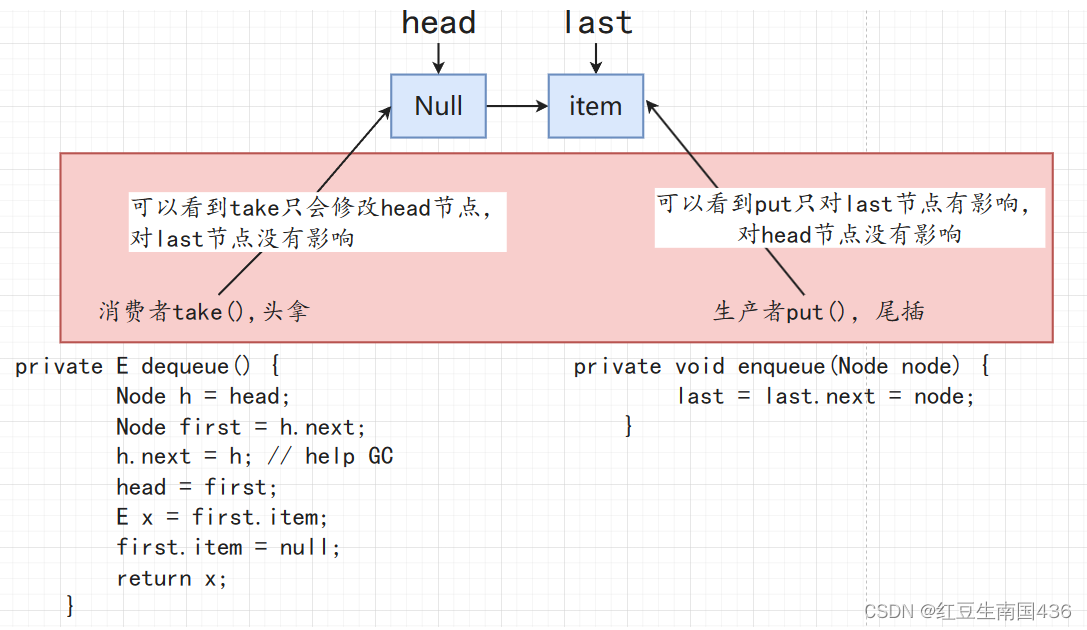 3.LinkedBlockingDeque
3.LinkedBlockingDeque
有单向链表的LinkedBlockingQueue,那么肯定有双向链表的。
·属性
static final class Node<E> { //可以看出是由双向链表组成的队列
E item;
Node<E> prev;
Node<E> next;
}
transient Node<E> first;
transient Node<E> last;
private transient int count;
private final int capacity;
final ReentrantLock lock = new ReentrantLock();
private final Condition notEmpty = lock.newCondition();
private final Condition notFull = lock.newCondition();
//构造方法
public LinkedBlockingDeque(int capacity) {
if (capacity <= 0) throw new IllegalArgumentException();
this.capacity = capacity;
}
可以看到该类只有一把锁,也就意味着,只要拿到了这把锁,那么就是接下来的操作就是单线程的了,也就没有并发,所以性能肯定是没有LinkedBlockingQueue好的。接下来看一些源码分析
·putFirst()
从队列头部放入元素
public void putFirst(E e) throws InterruptedException {
if (e == null) throw new NullPointerException(); //不允许放null的值
Node<E> node = new Node<E>(e); //可以看到这里没有伪节点,每个节点都是动态创建的
final ReentrantLock lock = this.lock;
lock.lock(); //拿到锁
try {
while (!linkFirst(node)) //linkFirst()是真正插入节点的方法,如果返回false(插入失败),那么意味着队列满了,则需要去条件队列中等待
notFull.await();
} finally {
lock.unlock();
}
}
//linkFirst()
private boolean linkFirst(Node<E> node) {
if (count >= capacity) //如果队列满了,返回false
return false;
Node<E> f = first; //拿到头节点
node.next = f;//将头节点设置为要插入节点的next(也即头插法)
first = node;//修改头节点
if (last == null) //如果是第一个节点,那么将last也指向该节点
last = node;
else
f.prev = node;//修改原来头节点的前驱节点
++count; //数量+1
notEmpty.signal(); //唤醒因为队列为null无法消费而去阻塞的消费者线程
return true;
}
·putLast()
从队列尾部插入元素
逻辑较为简单,当拿到锁以后就变为了操作双向链表了,在双向链表的尾部插入一个节点,这个操作很简单就不再赘述了
public void putLast(E e) throws InterruptedException {
if (e == null) throw new NullPointerException();
Node<E> node = new Node<E>(e);
final ReentrantLock lock = this.lock;
lock.lock();
try {
while (!linkLast(node))
notFull.await();
} finally {
lock.unlock();
}
}
//
private boolean linkLast(Node<E> node) {
// assert lock.isHeldByCurrentThread();
if (count >= capacity)
return false;
Node<E> l = last;
node.prev = l;
last = node;
if (first == null)
first = node;
else
l.next = node;
++count;
notEmpty.signal();
return true;
}
·takeFirst()
从队列头部拿元素,上锁后变为双向链表中从头部移除一个节点,不再赘述。
public E takeFirst() throws InterruptedException {
final ReentrantLock lock = this.lock;
lock.lock(); //上锁
try {
E x;
while ( (x = unlinkFirst()) == null)
notEmpty.await();
return x;
} finally {
lock.unlock();
}
}
//
private E unlinkFirst() {
Node<E> f = first;
if (f == null)
return null;
Node<E> n = f.next;
E item = f.item;
f.item = null;
f.next = f; // help GC
first = n;
if (n == null)
last = null;
else
n.prev = null;
--count;
notFull.signal();
return item;
}
从Node节点的数据结构可以看出,只有一把锁,所以只要拿到锁就变成单线程操作了,就是对双向链表进行增删改查了,逻辑比较简单,就不再赘述了。
4.LinkedTransferQueue
基于链接节点的无界的TransferQueue。 这个队列相对于任何给定的生产者订购元素FIFO(先进先出)。 队列的头部是那些已经排队的元素是一些生产者的最长时间。 队列的尾部是那些已经在队列上的元素是一些生产者的最短时间。
·示例
new Thread(() -> {
try {
log.debug("start--");
Object take = linkedTransferQueue.take(); //如果队列中没有元素,那么会阻塞
log.debug("{}", take);
} catch (InterruptedException e) {
e.printStackTrace();
}
}).start();
Thread.sleep(5000);
linkedTransferQueue.transfer(1);//放入一个元素并且唤醒阻塞线程
}
//运行结果
2024-01-25 10:45:25 [Thread-0] - start-- //可以看出这里被阻塞了
2024-01-25 10:45:30 [Thread-0] - 1 //拿到了数据
从这个简单的示例中可以看出该类实现了生产者消费者模型,也即数据交换模型。
·属性
public LinkedTransferQueue() { //空的构造函数
}
private static final int FRONT_SPINS = 1 << 7; =2^7
private static final int CHAINED_SPINS = FRONT_SPINS >>> 1; 2^6
static final int SWEEP_THRESHOLD = 32;
static final class Node {
/*
判断是生产数据的节点还是消费数据的节点,
false表示消费
true表示生产
*/
final boolean isData;
/*
数据保存的地方
对于生产节点,item保存数据
对于消费节点,item保存从生产节点中获得的数据
*/
volatile Object item;
volatile Node next; //下一个节点
volatile Thread waiter; //要被阻塞的线程对象保存在这里,留给唤醒我的线程使用
final boolean isMatched() { //判断是否匹配
Object x = item; //拿到节点的item值
/*
如果是生产节点,那么isData=true,初始item为生产的值,当被匹配成功后,item为消费者的null值(数据交换)
那么此时x==null为true isData为true,所以为true,那么代表着生产者匹配成功了
对于消费节点,isData=false,匹配成功后,那么item为生产者的值(数据交换),那么此时x!=null也即false,
isData=false,即false=flase,代表消费者匹配成功。
那么第一个x==this代表着数据指向自己(这是什么意思?后续再继续分析)
*/
return (x == this) || ((x == null) == isData);
}
transient volatile Node head;
private transient volatile Node tail;
//对被取消的节点进行清理失败的票数计数
private transient volatile int sweepVotes;
private static final int NOW = 0; // for untimed poll, tryTransfer
private static final int ASYNC = 1; // for offer, put, add //异步非阻塞操作
private static final int SYNC = 2; // for transfer, take //同步阻塞操作
private static final int TIMED = 3; // for timed poll, tryTransfer
}
可以看到该类竟然没有锁,并且也没有伪节点,而是一个单链表,那么意味着生产者和消费者作用在同一条链表上,那么看看到底是如何工作的。
·transfer()
//生产者放入数据
public void transfer(E e) throws InterruptedException {
/*
e代表要传递的数据
true代表当前有数据要传递
SYNC代表同步等待
0代表没有超时
说明这是一个生产者线程
*/
if (xfer(e, true, SYNC, 0) != null) {
Thread.interrupted(); // failure possible only due to interrupt
throw new InterruptedException();
}
}
/*
注意:如果生产者和消费者匹配成功了,那么数据将会互换,也即item的值将会交换(这也是我们想要的结果),
1.所以下面在判断item!=null ==isData时,对于生产者而言,原来的item=数据,匹配成功后为null,而isData=true, 所以item!=null ==isData为(false == true即如果被匹配了,那么此判断为false,也即生产者被匹配,同理消费者也是如此)
2.当线程被删除后,如何标识自己要被删除了?只能用一个东西来标识自己,在该类中使用的是item指向自己来标识自己要被删除了,因为无论是生产者还是消费者都要和item打交道
*/
//xfer()
private E xfer(E e, boolean haveData, int how, long nanos) {
if (haveData && (e == null))
throw new NullPointerException(); //如果为生产线程,那么数据不能为null
Node s = null; //临时节点 // the node to append, if needed
retry: //标记,Java中很少使用
for (;;) { // restart on append race
for (Node h = head, p = h; p != null;) { // 从头节点开始找到并且匹配节点
boolean isData = p.isData; //拿到当前节点的类型(是生产者还是消费者)
Object item = p.item; //拿到要交换的数据
/*
item!=p代表自己没被取消
(item != null) == isData 生产者item如果没被匹配,那么就不为null,则为true,生产者的isData本来就为true,所以这个判断为true时就代表没被匹配,如果没被匹配就继续往下执行,
*/
if (item != p && (item != null) == isData) { // unmatched
//如果是同一种类型的,那么结束循环
if (isData == haveData) // can't match
break;
/*
p节点和当前节点的类型相反(一个是生产者一个是消费者),那么cas尝试匹配,
如果p是消费线程,那么则将p的item置为e(e是生产者的数据),
如果p为生产线程,那么此时e为null,则将p的item置为null,代表匹配成功了,
如果cas成功,那么需要将p节点断开,继续下面的操作
*/
if (p.casItem(item, e)) { // match
//q默认是匹配成功的节点p,并且q不能是头节点
for (Node q = p; q != h;) {
Node n = q.next; //取q的后继节点// update by 2 unless singleton
/*
head == h 头节点没有变化 并且
如果q是最后一个节点,那么修改q为head
否则修改q的后继节点为头节点,因为是尾插,
所以越后面的节点越不容易被取消,下次匹配时也是先匹配头节点
*/
if (head == h && casHead(h, n == null ? q : n)) {
//断开next指针,将next指向自己
h.forgetNext();
break;
} // advance and retry
if ((h = head) == null ||
(q = h.next) == null || !q.isMatched())
break; // unless slack < 2
}
//唤醒p节点的等待线程
LockSupport.unpark(p.waiter);
//将值返回即可
return LinkedTransferQueue.<E>cast(item);
}
}
//执行到这里,上面的p节点已经被匹配,去p的后继节点,如果p.next=p(p=n)的话,表明p已经被移除,
此时将p设置为新的头节点并且继续循环,否则继续尝试匹配p.next
Node n = p.next;
p = (p != n) ? n : (h = head); // Use head if p offlist
}
if (how != NOW) { // No matches available
if (s == null)
s = new Node(e, haveData); //初始化等待节点
Node pred = tryAppend(s, haveData);//将节点插入到链表中
if (pred == null)//插入链表失败,重试
continue retry; // lost race vs opposite mode
if (how != ASYNC) //准备阻塞
return awaitMatch(s, pred, e, (how == TIMED), nanos);
}
return e; // not waiting
}
}
·tryAppend()
private Node tryAppend(Node s, boolean haveData) { //haveData代表线程的种类(是生产线程还是消费线程)
for (Node t = tail, p = t;;) { // move p to last node and append
Node n, u; // temps for reads of next & tail
if (p == null && (p = head) == null) {
if (casHead(null, s))
return s; // initialize
}
else if (p.cannotPrecede(haveData))
return null; // lost race vs opposite mode
else if ((n = p.next) != null) // not last; keep traversing
p = p != t && t != (u = tail) ? (t = u) : // stale tail
(p != n) ? n : null; // restart if off list
else if (!p.casNext(null, s))
p = p.next; // re-read on CAS failure
else {
if (p != t) { // update if slack now >= 2
while ((tail != t || !casTail(t, s)) &&
(t = tail) != null &&
(s = t.next) != null && // advance and retry
(s = s.next) != null && s != t);
}
return p;
}
}
}
该方法的总体逻辑如下:
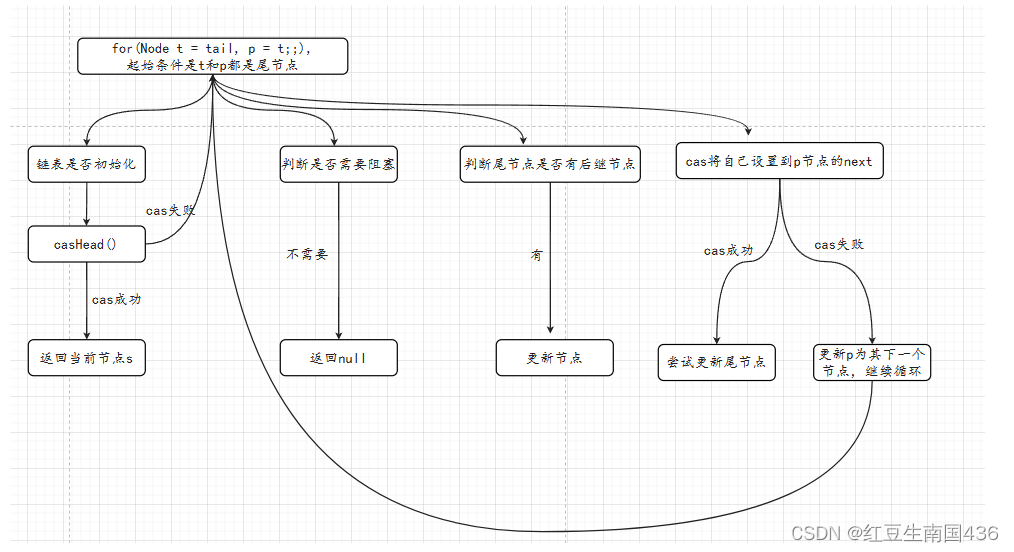
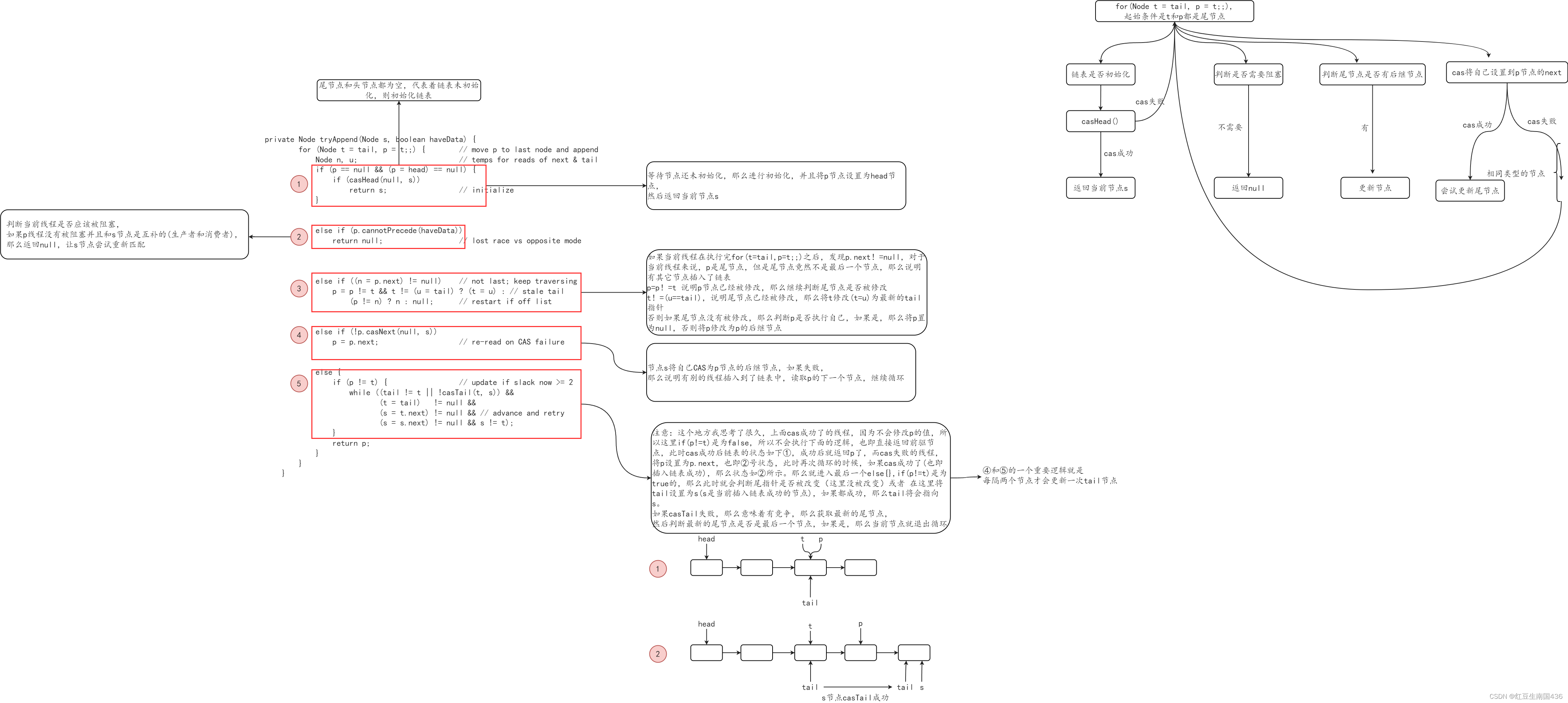
·awaitMatch()
看下是如何阻塞线程的
//s是当前节点 pred是前一个节点 e是要交换的数据
private E awaitMatch(Node s, Node pred, E e, boolean timed, long nanos) {
final long deadline = timed ? System.nanoTime() + nanos : 0L;
Thread w = Thread.currentThread();//获取当前执行线程
int spins = -1; // 自旋次数
ThreadLocalRandom randomYields = null; // bound if needed
for (;;) {
Object item = s.item; //当前节点的数据
if (item != e) { //说明当前节点已经匹配成功 // matched
// assert item != s;
//将item指向自己
s.forgetContents(); // avoid garbage
return LinkedTransferQueue.<E>cast(item);
}
//如果线程被中断,返回原始值
//或者超时,则通过cas将当前节点的item设置为自己,注意这里的cas,如果在超时和被匹配中,如果先匹配成功,那么即使超时也不算
if ((w.isInterrupted() || (timed && nanos <= 0)) &&
s.casItem(e, s)) { // cancel
unsplice(pred, s); //如果是,那么将s节点从链表中移除
return e;
}
//初始化自旋次数
if (spins < 0) { // establish spins at/near front
if ((spins = spinsFor(pred, s.isData)) > 0)
randomYields = ThreadLocalRandom.current();
}
else if (spins > 0) { // spin 开始自旋
--spins;
if (randomYields.nextInt(CHAINED_SPINS) == 0) //用来释放cpu资源的随机数,自旋优化
Thread.yield(); // occasionally yield
}
else if (s.waiter == null) { // 设置等待线程
s.waiter = w; // request unpark then recheck
}
else if (timed) {
nanos = deadline - System.nanoTime();
if (nanos > 0L)
LockSupport.parkNanos(this, nanos);
}
else { //阻塞
LockSupport.park(this);
}
}
}
·unsplice()
final void unsplice(Node pred, Node s) { //s是当前节点,是需要被移除的节点,pred是前驱节点
s.forgetContents(); // 将s的item指向自己
//s不是头节点并且s是pred的后继节点
if (pred != null && pred != s && pred.next == s) {
Node n = s.next; //获取s的后继节点
if (n == null || //后继节点为null ,意味着s是最后一个节点,则直接进入,否则意味着s不是最后一个节点
//或者 后继节点不等于s, 则CAS将前驱节点的next节点设置为s的next节点,这条语句就能将s节点从链表中移除了
//并且判断前驱节点是否被匹配。如果没有被匹配,那么直接返回
(n != s && pred.casNext(s, n) && pred.isMatched())) {
for (;;) { // check if at, or could be, head
Node h = head; //拿到最新的头节点
//如果前驱节点是头节点或者s是头节点或者此时链表为null,直接返回
if (h == pred || h == s || h == null)
return; // at head or list empty
if (!h.isMatched())//如果头节点没有被匹配,直接结束循环
break;
Node hn = h.next; //拿到头节点的后续节点
if (hn == null) //链表中只有头节点,此时队列为null,直接返回
return; // now empty
if (hn != h && casHead(h, hn))
h.forgetNext(); // advance head
}
if (pred.next != pred && s.next != s) { // recheck if offlist
for (;;) { // sweep now if enough votes
int v = sweepVotes;
if (v < SWEEP_THRESHOLD) {
if (casSweepVotes(v, v + 1))
break;
}
else if (casSweepVotes(v, 0)) {
sweep();
break;
}
}
}
}
}
}
5.SynchronousQueue
·简介
A blocking queue其中每个插入操作必须等待另一个线程相应的删除操作,反之亦然。 同步队列没有任何内部容量,甚至没有一个容量。 你不能peek在同步队列,因为一个元素,当您尝试删除它才存在; 您无法插入元素(使用任何方法),除非另有线程正在尝试删除它; 你不能迭代,因为没有什么可以迭代。 队列的头部是第一个排队的插入线程尝试添加到队列中的元素; 如果没有这样排队的线程,那么没有元素可用于删除,并且poll()将返回null 。 为了其他Collection方法(例如contains )的目的, SynchronousQueue充当空集合。 此队列不允许null元素。
·简单示例:
SynchronousQueue<Object> synchronousQueue = new SynchronousQueue<>();
new Thread(() -> {
Object ret = null;
try {
log.debug("生产者等待匹配中····");
synchronousQueue.put(1);
} catch (InterruptedException e) {
e.printStackTrace();
}
}).start();
Thread.sleep(3000);
new Thread(() -> {
Object ret = null;
try {
log.debug("消费者准备消费····");
ret = synchronousQueue.take();
log.debug("ret={}", ret);
} catch (InterruptedException e) {
e.printStackTrace();
}
}).start();
//结果:
2024-01-26 12:19:42 [Thread-0] - 生产者等待匹配中····
2024-01-26 12:19:45 [Thread-1] - 消费者准备消费····
2024-01-26 12:19:45 [Thread-0] - 匹配成功
2024-01-26 12:19:45 [Thread-1] - ret=1
//将上面2个线程互换得出的结果
2024-01-26 12:19:04 [Thread-0] - 消费者准备消费····
2024-01-26 12:19:07 [Thread-1] - 生产者等待匹配中····
2024-01-26 12:19:07 [Thread-1] - 匹配成功
2024-01-26 12:19:07 [Thread-0] - ret=1
可以看到线程必须匹配才能执行,如果生产者发现没有人等待消费,那么阻塞,同样消费者发现没有人生产,一样阻塞
·构造函数
public SynchronousQueue() {
this(false);
}
public SynchronousQueue(boolean fair) {
transferer = fair ? new TransferQueue<E>() : new TransferStack<E>();
}
可以看到该类的内部有两种实现,公平的和非公平的,默认是非公平的。
·公平:TransferQueue实现的
·非公平:TransferStack实现的
·put(E e)
将指定的元素添加到此队列,等待另一个线程接收它。并且如果没有消费者等待着消费,那么阻塞
public void put(E e) throws InterruptedException {
if (e == null) throw new NullPointerException(); //不允许放null值
if (transferer.transfer(e, false, 0) == null) { //调用transferer.transfer()
Thread.interrupted();
throw new InterruptedException();
}
}
·take()
检索并删除此队列的头,等待另一个线程插入它。并且如果没有生产者等待着被取走,那么阻塞
public E take() throws InterruptedException {
E e = transferer.transfer(null, false, 0); //可以看到都是调用transferer.transfer()方法
if (e != null)
return e;
Thread.interrupted();
throw new InterruptedException();
}
可以看到不管是生产者还是消费者都是调用transferer.transfer(),不过对于生产者而言,其数据不为null,而对于消费者而言其数据为null(这很容易理解)。
·transfer()公平实现
先看看由TransferQueue实现的transfer的工作原理
·属性
static final class QNode {
volatile QNode next; // next node in queue 下一个节点,可以看出是由单链表实现的
volatile Object item; // CAS'ed to or from null 数据
volatile Thread waiter; // to control park/unpark 等待线程
final boolean isData; //消费者还是生产者的标识
QNode(Object item, boolean isData) {
this.item = item;
this.isData = isData;
}
}
transient volatile QNode head;
transient volatile QNode tail;
transient volatile QNode cleanMe;
TransferQueue() { //可以看到初始化的时候会创建一个伪节点(不存放数据)
QNode h = new QNode(null, false); // initialize to dummy node.
head = h;
tail = h;
}
E transfer(E e, boolean timed, long nanos) {
QNode s = null; // constructed/reused as needed
boolean isData = (e != null);//e!null说明是生产者,即生产者的IsData=true,消费者为flase
for (;;) {
QNode t = tail;
QNode h = head; //将头节点和尾节点保存在线程栈上,注意Doug Lea写代码的风格就是保存旧值然后操作旧值,
//后续操作再用旧值和新值比较来判断是否产生了并发
if (t == null || h == null) // saw uninitialized value
continue; // spin
if (h == t || t.isData == isData) { // empty or same-mode
QNode tn = t.next;
if (t != tail) // inconsistent read
continue;
if (tn != null) { // lagging tail
advanceTail(t, tn);
continue;
}
if (timed && nanos <= 0) // can't wait
return null;
if (s == null)
s = new QNode(e, isData);
if (!t.casNext(null, s)) // failed to link in
continue;
advanceTail(t, s); // swing tail and wait
Object x = awaitFulfill(s, e, timed, nanos);
if (x == s) { // wait was cancelled
clean(t, s);
return null;
}
if (!s.isOffList()) { // not already unlinked
advanceHead(t, s); // unlink if head
if (x != null) // and forget fields
s.item = s;
s.waiter = null;
}
return (x != null) ? (E)x : e;
} else { // complementary-mode
QNode m = h.next; // node to fulfill
if (t != tail || m == null || h != head)
continue; // inconsistent read
Object x = m.item;
if (isData == (x != null) || // m already fulfilled
x == m || // m cancelled
!m.casItem(x, e)) { // lost CAS
advanceHead(h, m); // dequeue and retry
continue;
}
advanceHead(h, m); // successfully fulfilled
LockSupport.unpark(m.waiter);
return (x != null) ? (E)x : e;
}
}
}
·源码分析:
如果图片模糊可以查看该链接:
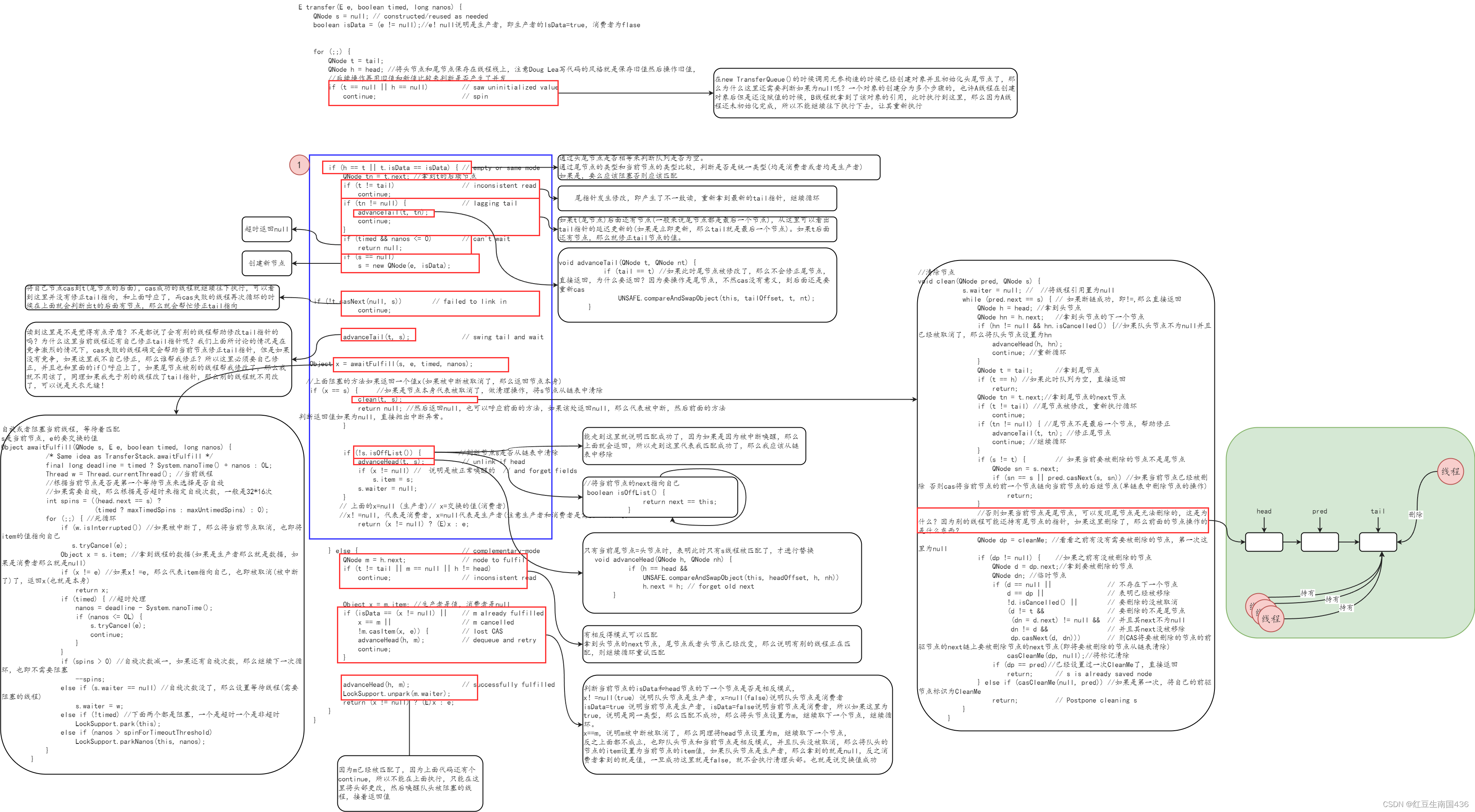 ·transfer()非公平实现
·transfer()非公平实现
由TransferStack实现的
·属性
static final int REQUEST = 0; //代表消费者
static final int DATA = 1; //代表生产者
static final int FULFILLING = 2; //代表当前节点处于配对中
//判断当前节点是否处于配对中
static boolean isFulfilling(int m) { return (m & FULFILLING) != 0; }
//线程节点
static final class SNode {
volatile SNode next; // next node in stack
volatile SNode match; // the node matched to this
volatile Thread waiter; // to control park/unpark
//思考一下:为什么这里不需要使用使用volatile修饰?
Object item; // data; or null for REQUESTs
int mode;
}
volatile SNode head;
·transfer()
E transfer(E e, boolean timed, long nanos) {
/*
* Basic algorithm is to loop trying one of three actions:
*
* 1. If apparently empty or already containing nodes of same
* mode, try to push node on stack and wait for a match,
* returning it, or null if cancelled.
*
* 2. If apparently containing node of complementary mode,
* try to push a fulfilling node on to stack, match
* with corresponding waiting node, pop both from
* stack, and return matched item. The matching or
* unlinking might not actually be necessary because of
* other threads performing action 3:
*
* 3. If top of stack already holds another fulfilling node,
* help it out by doing its match and/or pop
* operations, and then continue. The code for helping
* is essentially the same as for fulfilling, except
* that it doesn't return the item.
*/
SNode s = null; // constructed/reused as needed
int mode = (e == null) ? REQUEST : DATA;
for (;;) {
SNode h = head;
if (h == null || h.mode == mode) { // empty or same-mode
if (timed && nanos <= 0) { // can't wait
if (h != null && h.isCancelled())
casHead(h, h.next); // pop cancelled node
else
return null;
} else if (casHead(h, s = snode(s, e, h, mode))) {
SNode m = awaitFulfill(s, timed, nanos);
if (m == s) { // wait was cancelled
clean(s);
return null;
}
if ((h = head) != null && h.next == s)
casHead(h, s.next); // help s's fulfiller
return (E) ((mode == REQUEST) ? m.item : s.item);
}
} else if (!isFulfilling(h.mode)) { // try to fulfill
if (h.isCancelled()) // already cancelled
casHead(h, h.next); // pop and retry
else if (casHead(h, s=snode(s, e, h, FULFILLING|mode))) {
for (;;) { // loop until matched or waiters disappear
SNode m = s.next; // m is s's match
if (m == null) { // all waiters are gone
casHead(s, null); // pop fulfill node
s = null; // use new node next time
break; // restart main loop
}
SNode mn = m.next;
if (m.tryMatch(s)) {
casHead(s, mn); // pop both s and m
return (E) ((mode == REQUEST) ? m.item : s.item);
} else // lost match
s.casNext(m, mn); // help unlink
}
}
} else { // help a fulfiller
SNode m = h.next; // m is h's match
if (m == null) // waiter is gone
casHead(h, null); // pop fulfilling node
else {
SNode mn = m.next;
if (m.tryMatch(h)) // help match
casHead(h, mn); // pop both h and m
else // lost match
h.casNext(m, mn); // help unlink
}
}
}
}
·源码分析
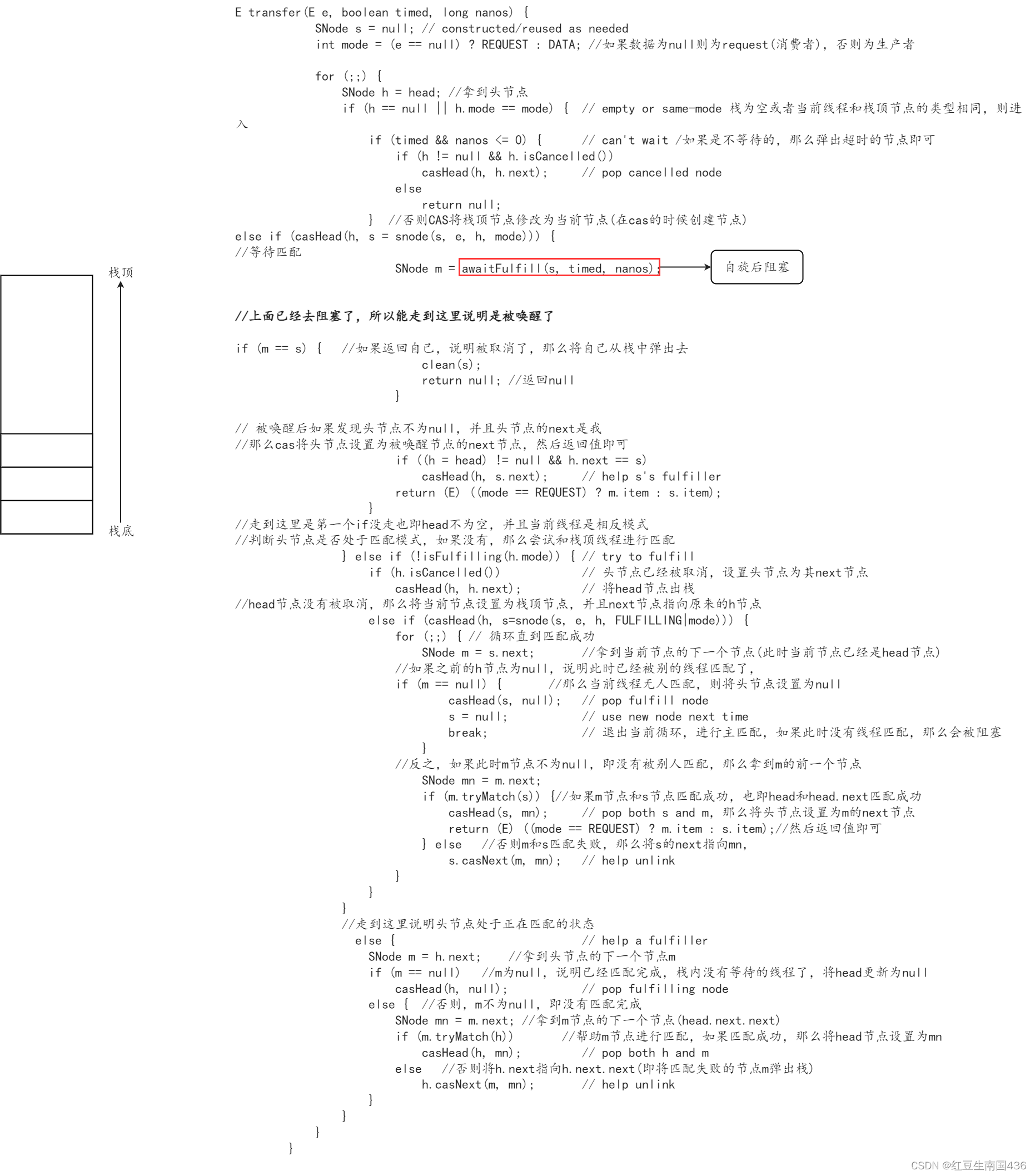
·小总结:
1.如果栈为空或者栈顶线程和当前线程是相同模式的节点,那么为当前线程生成一个新的节点插入到栈中等待匹配
2.如果栈顶线程和当前线程的模式相反,那么尝试将一个fulfilling节点压入栈中,然后对这个节点进行匹配,匹配成功将这个节点和被匹配成功的节点一起从栈中弹出,当然如果有别的线程此时进来那么会帮助弹出
3.如果栈顶出现了一个正在匹配的节点,那么尝试帮助它完成匹配并且出栈,然后开始自己的匹配
可以看出Stack和Queue的区别了,Stack是栈顶进栈顶匹配,而Queue是队尾进,队头匹配。
6.PriorityBlockingQueue
一个无界的blocking queue使用与PriorityQueue类相同的排序规则,并提供阻塞检索操作。 虽然这个队列在逻辑上是无界的,但由于资源耗尽,尝试的添加可能会失败(导致OutOfMemoryError )。 这个类不允许null元素。 根据natural ordering的优先级队列也不允许插入不可比较的对象(这样做在ClassCastException )。
·简单示例
priorityBlockingQueue.put(2);
priorityBlockingQueue.put(1);
Object ret = priorityBlockingQueue.take();
System.out.println("ret = " + ret); //ret=1
·属性
//默认数组的容量
private static final int DEFAULT_INITIAL_CAPACITY = 11;
//最大的容量,想想为什么要-8?(数组对象的头部需要保存数组的长度)
private static final int MAX_ARRAY_SIZE = Integer.MAX_VALUE - 8;
//保存元素的数组
private transient Object[] queue;
//队列中元素的个数
private transient int size;
//比较器
private transient Comparator<? super E> comparator;
//互斥锁
private final ReentrantLock lock;
//条件等待,因为是无界的,所以只有空,没有满
private final Condition notEmpty;
//等待数组分配时的自旋锁使用的变量
private transient volatile int allocationSpinLock;
//构造
public PriorityBlockingQueue(int initialCapacity,
Comparator<? super E> comparator) {
if (initialCapacity < 1)
throw new IllegalArgumentException();
this.lock = new ReentrantLock(); //锁
this.notEmpty = lock.newCondition(); //条件队列
this.comparator = comparator; //比较器
this.queue = new Object[initialCapacity]; //数组实现的队列
}
·put()
public void put(E e) {
offer(e); // never need to block
}
//-put()是调用offer()来完成的
public boolean offer(E e) {
if (e == null)
throw new NullPointerException(); //不允许放入null值
final ReentrantLock lock = this.lock;
lock.lock(); //上锁,以下操作变为单线程操作
int n, cap;
Object[] array;
//队列满了,进行扩容,while()保证直到扩容成功
while ((n = size) >= (cap = (array = queue).length))
tryGrow;
try {
Comparator<? super E> cmp = comparator;//拿到比较器
if (cmp == null) //如果比较为null,则通过Comparable来比较
siftUpComparable(n, e, array);
else
siftUpUsingComparator(n, e, array, cmp);
size = n + 1; //将队列中元素+1
notEmpty.signal();//唤醒因为没有元素take()而阻塞的线程
} finally {
lock.unlock(); //解锁
}
return true;
}
·tryGrow()
private void tryGrow(Object[] array, int oldCap) {
lock.unlock(); // 释放锁,不能因为扩容让其它操作无法执行
Object[] newArray = null;
//获取自旋锁并且将其cas为1
if (allocationSpinLock == 0 &&
UNSAFE.compareAndSwapInt(this, allocationSpinLockOffset,
0, 1)) {
try {
//如果原数组的容量小于64,那么新数组的容量为64+2,否则为64+32
int newCap = oldCap + ((oldCap < 64) ?
(oldCap + 2) : // grow faster if small
(oldCap >> 1));
//如果扩容后超过最大容量
if (newCap - MAX_ARRAY_SIZE > 0) { // possible overflow
//将原来的数组容量+1,如果原来容量就是最大值,那么+1会符号溢出
int minCap = oldCap + 1;
if (minCap < 0 || minCap > MAX_ARRAY_SIZE)
throw new OutOfMemoryError(); //抛出OOM
newCap = MAX_ARRAY_SIZE;//将新容量设置为默认最大值
}
//新容量大于老容量并且数组没有被修改引用,那么就创建一个新的数组
if (newCap > oldCap && queue == array)
newArray = new Object[newCap];
} finally {
allocationSpinLock = 0;//释放自旋锁
}
}
if (newArray == null) // 如果其它线程正在创建新数组,那么释放CPU资源,没必要做无意义的自旋
Thread.yield();
lock.lock();//操作原数组时必须上锁
//在原数组未改变的情况下进行数组复制并且替换原数组
if (newArray != null && queue == array) {
queue = newArray;
System.arraycopy(array, 0, newArray, 0, oldCap);
}
}
·take()
public E take() throws InterruptedException {
final ReentrantLock lock = this.lock;
lock.lockInterruptibly();//拿到可中断的锁
E result;
try {
while ( (result = dequeue()) == null) //如果此时队列中没有元素,那么去条件队列中阻塞
notEmpty.await();
} finally {
lock.unlock();
}
return result;
}
该类的实现比较简单,上了锁之后就是单线程操作,对于入队出队的操作就是堆的操作,这里就不再赘述了。






















 2817
2817











 被折叠的 条评论
为什么被折叠?
被折叠的 条评论
为什么被折叠?








